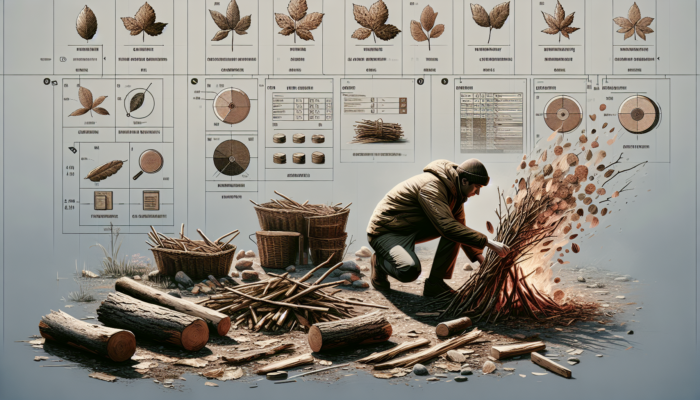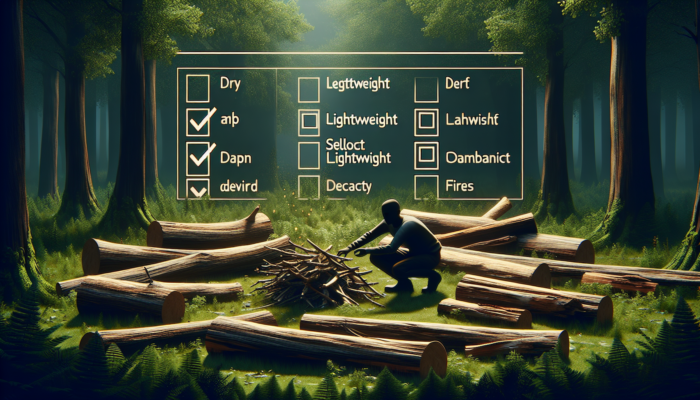Essential Strategies for Choosing the Ideal Location for Wilderness Fire-Making Success
Selecting the perfect spot for fire-making in the wild is a critical aspect that can enhance safety and enrich your outdoor experience. A well-chosen location not only minimizes risks but also strengthens your connection to the natural environment. As you prepare for your wilderness escapade, it is vital to evaluate both the advantages and hazards presented by your surroundings. Gaining insight into the local landscape, including its terrain and environmental characteristics, is essential for making educated choices that lead to a successful fire-making endeavor.
Analyzing Wind Patterns and Weather Conditions for Optimal Fire Safety

Understanding the dynamics of wind flow is paramount for ensuring both safety and efficiency in your fire-making efforts. Before igniting your fire, take a few moments to observe the prevailing wind direction and its intensity in your chosen location. Setting up your fire downwind from activities such as cooking or socializing not only keeps smoke from irritating your eyes but also cultivates a more enjoyable atmosphere for everyone involved. Furthermore, it is wise to consult weather forecasts; if rain is on the horizon, seek out a spot that offers natural shelter to safeguard your fire from unexpected precipitation. Look for natural windbreaks, like large boulders or dense clusters of trees, which can significantly diminish airflow around your fire.
On a more technical note, comprehending local weather patterns can be invaluable for effective fire-making. Some regions may experience rapid changes in weather that necessitate having backup plans ready, such as knowing how to quickly shield or extinguish your fire if conditions worsen. Trust your instincts and prioritize safety over convenience when selecting your fire site; this proactive mindset is essential for an enriching outdoor experience.
Identifying Elevated and Dry Ground for Enhanced Fire Performance
The success of your fire heavily depends on the quality of the ground beneath it. Elevated and arid locations are ideal since they help keep your fire ignited and reduce vulnerability to rain or moisture. When scouting for a suitable site, prioritize areas that have not been recently saturated by rain; hilltops and ridges are typically excellent selections. Wet ground can absorb heat and moisture, effectively extinguishing your flames before they have a chance to thrive.
Moreover, consider the surface composition where you intend to build your fire. Although leaf litter or dry grass can catch fire quickly, they may also burn too rapidly, leading to an unstable flame. Therefore, opt for rocky or sandy surfaces that allow your fire to breathe and provide a solid foundation. As you navigate the terrain, keep an eye out for natural barriers that can help contain your fire, preventing it from spreading uncontrollably and ensuring a safer experience for everyone present.
Establishing a Safe Fire Perimeter for Enhanced Fire Safety
Creating a secure perimeter around your fire is crucial and involves more than merely selecting the right ground. A vital step is to remove any flammable materials within a safe radius. This includes clearing away dry leaves, twigs, and other combustible debris that could easily ignite and lead to dangerous situations. Aim for a minimum distance of at least three feet around your fire site to ensure ample space for smoke to dissipate and for individuals to gather safely, reducing the risk of accidental burns or fires.
Additionally, assess the proximity of your fire to nearby structures, trees, or tents. A well-constructed fire should never be within reach of overhanging branches or shelters. The key to a successful fire-making endeavor lies in being proactive about safety; taking these precautions sets the stage for an enjoyable evening under the stars, free from concerns about your fire spreading uncontrollably.
Essential Materials to Gather for Successful Wilderness Fire-Making

No fire can flourish without the right materials, and knowing how to gather these essentials is vital for anyone aiming to excel at fire-making in the wild. The process begins by securing the smallest components and gradually builds up to larger fuel sources, with each step being crucial to achieving a resilient fire that can withstand the elements.
Choosing the Optimal Tinder for Quick Ignition
Tinder serves as the catalyst that ignites your fire, making the selection of suitable materials essential. The best options for tinder include dry leaves, grass, or birch bark, all of which catch sparks readily and ignite swiftly. Birch bark is particularly advantageous due to its natural oils, which facilitate ignition even in damp conditions.
When collecting tinder, ensure that the materials are entirely dry and devoid of moisture. A simple test is to crumble the leaves or grass; if they break easily, they are suitable for use. Avoid gathering green or damp materials, as these will hinder your fire's ability to ignite. If in doubt, search for dead plants or fallen tree bark, which often provide excellent sources of tinder.
Another effective strategy is to carry pre-prepared tinder in your gear. For instance, cotton balls dipped in petroleum jelly make excellent fire starters that ignite easily and burn long enough to catch larger kindling, significantly simplifying your fire-making efforts.
Collecting Quality Kindling for a Seamless Fire Transition
Once you've secured suitable tinder, the next step is gathering kindling. This consists of small, dry sticks and twigs that facilitate the transition from tinder to larger logs. As you explore your surroundings, look for dead branches on the ground that can be easily snapped, as these will work effectively as kindling.
When gathering kindling, aim for materials approximately the thickness of a pencil. This size allows for rapid ignition and burning, providing the necessary heat to ignite larger fuel sources. Layering your kindling in a crisscross pattern can enhance airflow, allowing the flames to grow more robustly as they transition to larger logs.
Remember, variety is key in this process. Collect kindling of different sizes to create a robust fire structure. By combining thinner twigs with slightly thicker sticks, you can ensure a steady progression in fire strength and longevity, ultimately enhancing your experience of fire-making in the wild.
Finding Quality Firewood for Sustained Heat and Light

The final step in material gathering involves acquiring firewood. Larger, dry logs are essential for sustaining your fire once it is established. When searching for firewood, target downed trees or branches that are not in direct contact with the ground, as these are more likely to be dry.
Select lightweight logs that produce a crisp sound when struck together, indicating they are dry and suitable for burning. Additionally, check for signs of rot or dampness; logs that feel heavy or have a spongy texture will yield minimal heat and create excessive smoke, which could ruin your fire-making experience.
As you gather firewood, consider how long you plan to maintain your fire. If you expect to be in the wild for an extended period, collect more firewood than you think you'll need. Building an abundant supply allows you to maintain a consistent fire that provides warmth and light throughout your time in the wilderness, ensuring a comfortable and enjoyable experience.
Mastering Fire-Starting Techniques for Wilderness Fire-Making Success
Developing proficiency in various fire-starting techniques is essential for anyone serious about their fire-making skills. Whether facing challenging weather conditions or aiming to impress your companions with your abilities, knowing multiple methods ensures you can adapt and succeed in fire-making in the wild.
Utilizing a Reliable Firestarter for Quick and Effortless Ignition
The most straightforward and dependable method for fire-making in the wild involves using a firestarter, such as a lighter or matches. This technique proves particularly beneficial in wet or windy conditions, where traditional methods might falter. When using a lighter, choose one that is windproof, especially if you anticipate breezy environments that could complicate your efforts.
Preparation of your materials in advance is crucial when using a firestarter. Ensure your tinder is well-arranged to allow easy access to flames. Light the tinder and observe as it ignites, sending flames upward to catch the kindling. Always keep a backup firestarter on hand, such as waterproof matches, to ensure you are never caught unprepared in the wilderness.
While firestarters offer incredible convenience, they can also serve as valuable learning tools. Spend time practicing different techniques with your firestarter, adjusting material positioning until you discover the most effective method for your particular situation. This skill can significantly influence your fire-making success, especially in challenging conditions where every moment matters.
Implementing the Flint and Steel Method for Traditional Fire Starting
For those adventurous enough to embrace traditional techniques, the flint and steel method provides a reliable option for fire-making in the wild. By striking flint against steel, you generate sparks that can ignite your carefully prepared tinder. Understanding the science behind this method can greatly improve your chances of success and elevate your outdoor skills.
When employing this method, ensure your flint is of high quality and your steel is sharp. Proper technique is essential; strike the flint at a sharp angle to produce the best sparks. Position your tinder close to the point of impact to catch the sparks quickly, resulting in successful ignition.
This method is particularly advantageous in wet conditions, where matches may fail. The sparks generated by flint and steel can often ignite damp tinder that would otherwise resist flame. Practicing this technique not only enhances your survival skills but also adds an exciting challenge to your fire-making experience.
Exploring Friction-Based Fire-Starting Techniques for the Adventurous Spirit
Although challenging, friction-based fire-starting is a rewarding skill for anyone venturing into the wild. Techniques such as the bow or hand drill require practice and patience, making them ideal skills to master before finding yourself in a survival situation.
The bow drill method involves creating a notch in a flat piece of wood and using a spindle with a bow to generate friction and heat. This process necessitates precise movements and a consistent rhythm, as friction generates a small ember that can be transferred to your tinder for ignition.
When mastering friction-based methods, consider the type of wood being used; softer woods tend to ignite more effectively than harder varieties. Regular practice is essential to develop muscle memory and increase your chances of success. Beyond being a valuable skill, it can also serve as an impressive party trick among fellow adventurers, showcasing your resourcefulness and ingenuity.
Building Your Fire for Maximum Efficiency in Wilderness Fire-Making
Successfully constructing your fire is vital for achieving a consistent, long-lasting flame. Various fire-building techniques offer unique advantages and can be adapted based on the conditions you encounter. Understanding how to assemble your fire will elevate your fire-making in the wild experience, making it more enjoyable and efficient.
Creating a Teepee Structure for Enhanced Airflow and Flame Growth
The teepee structure is one of the most popular fire-building methods, and for good reason. By arranging kindling in a teepee shape around your tinder, you create ample airflow, encouraging the flames to grow rapidly and efficiently. The open design allows heat to circulate, which is vital for igniting larger logs and sustaining a robust fire.
Begin by placing your tinder in the center, then lean the kindling around it to form a cone. Be sure not to pack the kindling too tightly; sufficient airflow is essential for maintaining the fire. As the tinder ignites and embers form, the kindling will catch fire and generate heat, paving the way for larger firewood to ignite.
This structure is particularly effective in dry weather, facilitating a quick start. However, in windy conditions, the teepee may require modifications to prevent it from collapsing. Consider reinforcing it by placing larger logs around the base to stabilize the structure and protect it from being blown over by gusts of wind.
Utilizing the Log Cabin Method for a Stable and Long-Lasting Fire
The log cabin method is an excellent choice for those seeking a stable and enduring fire. Stacking logs in a square, cabin-like formation creates a solid structure that can withstand wind and provide sustained heat. This configuration is ideal for prolonged camping trips or gatherings around the fire.
To construct a log cabin fire, start with a small base of tinder and kindling. Once the tinder is ignited, gradually stack larger logs around the kindling in a square formation. Ensure the logs are not tightly packed to allow airflow to feed the flames. The log cabin design is visually pleasing and maintains a steady burn, keeping the fire alive through the night and providing a comforting glow.
As you build your log cabin, consider the size of your logs. Opt for a mix of smaller and larger logs to ensure a steady fuel source. This method creates a warm and inviting atmosphere, perfect for storytelling and bonding with fellow campers under the stars.
Implementing the Lean-To Configuration for Versatile Fire Building
The lean-to configuration is a versatile fire-building method, especially useful in windy conditions. By placing a larger log as a windbreak, you can lean smaller sticks against it to create a shelter for your fire. This technique is particularly beneficial for protecting your flames from adverse weather while ensuring adequate airflow for combustion.
To construct a lean-to fire, start with your windbreak log positioned at a 45-degree angle to the prevailing winds. Next, place your tinder and kindling at the base, leaning smaller sticks against the windbreak log. This structure not only shelters the fire from wind but also directs heat towards your gathered fuel, helping maintain warmth and ensuring a steady burn.
Efficiency is crucial when utilizing this method. Be mindful of the lean-to's height; if it's too short, the flames may not effectively reach the kindling. Adjusting the angle of the windbreak log can also improve your fire's performance by optimizing airflow and keeping the fire burning steadily, allowing you to fully enjoy your time outdoors.
Utilizing the Top-Down Fire Lay for Reduced Maintenance and Extended Burn Time
The top-down fire lay is an innovative technique that allows for a longer-lasting burn with less maintenance. By starting with larger logs at the bottom and layering smaller logs and kindling on top, you create a fire that ignites from the top down. This approach is particularly effective for seasoned campers seeking a hassle-free fire-making experience.
To build a top-down fire lay, arrange your largest logs in a square shape, followed by a layer of medium-sized logs. Finally, place your tinder and kindling on top, ensuring they can easily catch fire. As the fire burns downwards, it gradually ignites the layers beneath, providing sustained heat and minimal need for constant attention.
This technique is efficient and reduces smoke production, making it ideal for camping in areas sensitive to fire regulations. Incorporating this method into your fire-making repertoire will simplify the process and enhance your outdoor adventures, enabling you to focus on enjoying nature rather than constantly tending to the fire.
Effective Fire Maintenance Techniques for Wilderness Fire-Making
Once your fire is ablaze, effective maintenance becomes crucial for ensuring a steady burn and maintaining a safe environment. Understanding how to manage your fire enhances your experience and keeps you and others safe while enjoying the beauty of fire-making in the wild.
Gradually Adding Fuel for a Steady and Consistent Flame
One key to maintaining a vibrant fire is the gradual addition of fuel. By feeding your fire slowly, you avoid smothering the flames and maintain a consistent heat output. Start with smaller logs and only transition to larger ones once the fire has established itself and is robust.
Keep a close eye on your fire and assess the amount of heat and light it generates. If the flames begin to wane, carefully add more wood while ensuring proper airflow. Avoid tossing large logs onto the fire all at once, as this can disrupt the flames and lead to a suffocating fire that struggles to thrive. Instead, opt for a measured approach, allowing the fire to grow naturally and maintain its intensity.
In high-wind conditions, adjust your strategy by being cautious with the amount and type of fuel you add. Larger logs may extinguish flames if added hastily, so remain vigilant and observe the fire's behavior closely. This proactive approach guarantees a consistent and enjoyable fire experience throughout your camping trip, allowing you to relax and soak in the beauty of your surroundings.
Adjusting Airflow for Optimal Fire Performance
Airflow is a vital component in determining the intensity of your fire. A well-oxygenated fire burns hotter and more efficiently, while a lack of air can result in excessive smoke and weak flames. Adjusting the arrangement of your logs is an effective method for controlling airflow and fire intensity.
If your fire appears sluggish or produces excessive smoke, consider repositioning the logs to create more space for oxygen to enter. This can be achieved by gently shifting the logs or adding strategically placed kindling to create channels for airflow. Conversely, if the fire is burning too hot and rapidly, you can slightly close off airflow by rearranging the logs closer together to maintain a balanced burn.
Learning how to manage airflow effectively will lead to a more enjoyable fire-making experience. This will allow you to fully embrace the beauty of the wilderness while staying warm and safe amidst nature's wonders.
Prioritizing Fire Safety for a Worry-Free Outdoor Experience
Maintaining a safe fire environment is paramount for all outdoor enthusiasts. Regularly monitoring your fire and surroundings will help prevent it from spreading and ensure it remains contained and manageable.
Always keep a bucket of water or sand nearby to quickly address any unexpected flare-ups. Be vigilant about the wind direction and its influence on the fire. If you notice sparks flying or flames reaching higher than expected, it may be time to adjust your setup or extinguish the fire entirely to mitigate potential hazards.
Additionally, establish a perimeter around your fire to keep it safe from others. Encourage guests to maintain a safe distance and never leave the fire unattended, especially if children or pets are present. Your commitment to fire safety will enhance everyone's experience, allowing you to relish the warmth and light of your fire without unnecessary worry or concern.
Properly Extinguishing Your Fire After Wilderness Fire-Making
Properly extinguishing your fire is just as crucial as starting and maintaining it. Leaving a fire unattended or failing to put it out completely can lead to wildfires and other hazards that threaten the environment and its inhabitants. Understanding the best techniques for extinguishing your fire ensures that you leave nature as you found it, making it safe for future visitors and preserving the wilderness's natural beauty.
Effective Dousing with Water for Campfire Extinguishment
Dousing your fire with water is one of the most effective methods of extinguishing a campfire. Pour water over the flames until they are entirely out, then stir the ashes with a stick to ensure no embers remain. This process is vital, as hidden embers can reignite if left untreated, posing a fire risk.
When pouring water, do so slowly and cautiously to avoid creating steam, which can lead to burns. Make sure to saturate all materials in the fire pit, as any remaining dry wood can easily reignite, leading to potential hazards.
After extinguishing your fire, it’s essential to inspect the area again to ensure everything is cool to the touch before leaving. Adopting this practice will help prevent potential wildfires and maintain the integrity of the wilderness around you, ensuring a safe and responsible outdoor experience.
Smothering the Fire with Dirt for Quick Extinguishment
Another effective fire extinguishing technique involves smothering the fire with dirt or sand. This method removes the oxygen supply, ensuring the flames die out completely. This technique is particularly useful in areas where water may be scarce or when the goal is to minimize excess smoke that could affect the environment.
To implement this method, carefully scoop dirt or sand over the fire, completely covering all embers and materials. Ensure the fire is fully covered, as any exposed hotspots can reignite when conditions are favorable, posing a risk to the surrounding area.
Like the water method, after smothering the fire, always check the ashes to confirm they are cool before leaving the site. This additional step is critical in preventing unintentional wildfires and demonstrates respect for the environment and its preservation.
Conducting a Heat Check After Extinguishing the Fire
After extinguishing your fire, checking for residual heat is essential to ensure it is completely out. Gently touch the ashes with your fingers; if they feel warm, the fire might not be fully extinguished and could reignite if left unattended.
Continue to douse or smother any remaining heat until everything is cool. This final check ensures that the fire does not reignite, prioritizing safety for the environment and future visitors who may use the same area.
Always remember, taking these precautions not only protects the wilderness but enhances your experience, allowing you to leave without the worry of any lingering embers that could threaten the natural surroundings.
Utilizing a Fire Extinguisher for Added Fire Safety
While less common in outdoor settings, having a fire extinguisher on hand can provide significant benefits, especially in high-risk areas or during dry seasons when fire dangers are escalated. To use a fire extinguisher effectively, aim the nozzle at the base of the fire and squeeze the handle. Sweep the nozzle from side to side until the flames are completely extinguished, ensuring thorough coverage.
This method offers an additional layer of safety and peace of mind, particularly when camping with groups or in areas where fire safety regulations are stringent. Familiarizing yourself with your fire extinguisher and practicing its use can prepare you for unexpected situations that may arise during your outdoor adventures.
In summary, while fire-making is a cherished skill in the wild, it comes with important responsibilities. Ensuring your fire is safely extinguished protects the environment and your fellow adventurers, allowing everyone to enjoy the beauty of nature without fear of fire-related hazards.
Environmental Considerations for Responsible Fire-Making in the Wilderness
While fire-making in the wild provides immense enjoyment, it is equally vital to consider the environmental impact of your activities. Adopting responsible fire-making techniques helps ensure that the wilderness remains pristine and enjoyable for future generations, promoting a sustainable outdoor culture.
Minimizing Your Environmental Footprint During Fire-Making
Choosing a fire site that minimizes environmental damage is crucial to responsible outdoor ethics. Whenever possible, utilize existing fire rings or established fire pits to reduce the impact on surrounding flora and fauna, thereby preserving the natural landscape for future visitors.
When selecting a location, consider the sensitivity of local ecosystems and avoid areas abundant with wildlife or rare plants. Designating a sustainable fire site helps conserve natural habitats and ensures that your fire-making activities align with Leave No Trace principles, contributing to the preservation of nature.
Moreover, consider the materials you use for your fire. Whenever feasible, opt for firewood sourced from dead and downed timber rather than cutting down live trees. This practice maintains the integrity of the ecosystem while providing ample fuel for your fire, ensuring that your outdoor activities have a minimal ecological footprint.
Respecting Local Fire Regulations and Guidelines for Safety
Fire regulations can vary significantly depending on your camping location, making it crucial to research local laws and guidelines before lighting a fire. Many national parks and forests have specific regulations in place to safeguard against wildfires and protect the delicate balance of wildlife and vegetation.
Understanding fire restrictions may involve checking weather conditions or obtaining necessary permits in certain areas. Respecting these regulations not only helps you avoid fines but also contributes to preserving the environment and the safety of all visitors.
Stay informed about fire bans or restrictions, particularly during dry seasons when fire risks are heightened. Your commitment to adhering to these guidelines ensures that you enjoy a safe and responsible fire-making experience while minimizing the potential for environmental harm.
Practicing Proper Waste Disposal for Environmental Stewardship
Proper waste disposal is critical for maintaining the beauty of our wilderness areas. When camping, make sure to pack out all trash and leftover materials, including food scraps and non-biodegradable items. This commitment to cleanliness preserves the landscape's natural beauty and protects wildlife from harmful interactions with human waste.
Utilizing designated bins when available and adhering to Leave No Trace principles helps protect wildlife and ensures a clean environment for future visitors. Ensure that any remnants of your fire are also disposed of correctly, removing any unburned materials or ashes from your campsite to leave the area as you found it.
Taking these steps contributes to preserving nature, allowing others to enjoy the beauty of wild spaces without the burden of litter or environmental degradation. Committing to responsible practices enhances your outdoor adventures while respecting the delicate balance of nature and its ecosystems.
Frequently Asked Questions About Wilderness Fire-Making
What is the best method to start a fire in wet conditions?
The most effective way to start a fire in wet conditions is to use a firestarter, such as waterproof matches or a reliable lighter, along with dry tinder like birch bark. This combination ensures a successful ignition.
How can I tell if wood is dry enough to burn?
Dry wood will produce a hollow sound when struck together and feel light in weight. If it is damp or feels heavy, it likely won't burn effectively, making it unsuitable for your fire.
What is the safest method to extinguish a fire?
The safest way to extinguish a fire is to douse it with water until it is completely out, stirring the ashes to ensure that no embers remain, thereby preventing potential hazards.
Is it advisable to use green wood for fire-making?
Green wood is not recommended as it contains moisture that hinders combustion and produces excessive smoke. Always opt for dry wood to ensure effective burning and a cleaner fire.
How do I build a fire in windy conditions?
To build a fire in windy conditions, utilize a lean-to configuration for wind protection and arrange your kindling to allow for good airflow. This will enhance your fire's stability and performance.
What materials are best suited for tinder?
Dry leaves, grass, and birch bark are ideal tinder materials. These options catch sparks easily and ignite quickly, making them excellent choices for starting a fire.
How far away should I set up my fire from my tent?
Setting up your fire at least 10 feet away from your tent is recommended to prevent heat damage and reduce the risk of fire spreading, ensuring a safe camping experience.
Is it necessary to check with local regulations before making a fire?
Yes, always check local regulations regarding fire-making. Many areas have specific rules or bans in place to prevent wildfires, protect wildlife, and ensure responsible outdoor behavior.
What should I do if my fire starts to spread?
If your fire starts to spread, immediately douse it with water or smother it with dirt, and use a shovel or stick to break apart the burning materials to prevent further spread and ensure safety.
Can I leave my fire unattended for a short while?
It is not advisable to leave your fire unattended at any time. Always ensure it is fully extinguished before stepping away, prioritizing safety for yourself and others in the area.
Explore our world on X!
The post Fire-Making in the Wild: Essential Skills and Tips appeared first on Survival Bite.
The Article Essential Skills and Tips for Fire-Making in the Wild Was Found On https://limitsofstrategy.com

